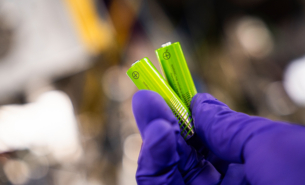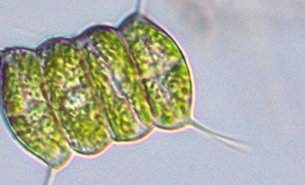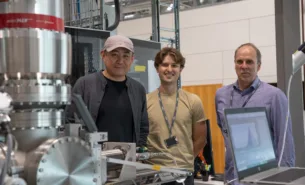Researchers have for the first time revealed the mechanism behind artificial photosynthesis. The study is an important step towards more efficient and tailored devices for local sustainable energy production.
Read the press release from Max Planck Institute and news on phys.org
Photosynthesis is the process in plants that use sunlight to convert carbon dioxide to oxygen and sugars to fuel growth. It is a longtime dream in the sustainable energy production field to be able to emulate the photosynthesis reaction. It could be used to create hydrogen for fuel from water and sunlight or convert carbon dioxide to useful chemicals.
“We observe nature and try to mimic its’ way of making fuel using sunlight”, says Sonia Żółtowska, one of the authors of the study.
The semiconductor carbon nitride is a photocatalyst, which means that it can facilitate chemical reactions on its surface, such as breaking adsorbed molecules apart in the presence of sunlight. It has been known as a promising candidate for artificial photosynthesis since 2009. Since then, much effort has gone into optimising and tweaking its properties to make it even more efficient. However, the detailed mechanism behind the catalytic reaction has remained unknown until now.
“A detailed understanding of the photocatalytic mechanism and highlighting the critical steps and triggers for carbon nitride opens for designing an even more optimal material. This way, we don’t have to test every single material but can theoretically understand how the reaction would work on different materials,” says Paolo Giusto, another author.
A research team studied the carbon nitride surface during water splitting, which is the production of hydrogen and oxygen gas from adsorbed water molecules in the presence of artificial sunlight. The unique experimental setup at beamline SPECIES allows the researchers to combine these prerequisites and get a detailed view of what is going on using several experimental methods at once.
“Being able to test the material during the reaction was the key to our study. MAX IV has a quite unique setup with the opportunity to do spectroscopy under ambient pressure while simulating the sunlight on the sample. There are only a few similar setups around the world that can do that,” says Paolo. “We really want to thank the beamline staff. They were a big help and provided fast support on every issue that came up during the experiment and really pushed the work forward.”
The team plan future studies of other surface reactions.
“There were a lot of preparations for the experiment. We really wanted to make it right, consistent and reproducible,” says Sonia. “The results we acquired were very eye-opening, also after ten years in the business.”




